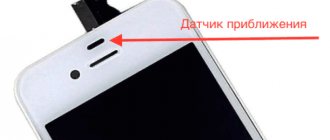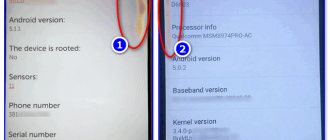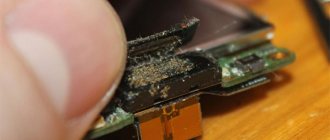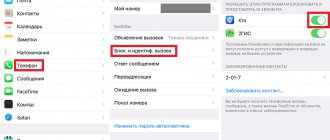Your phone's speaker grille is constantly exposed to a variety of impacts, even when it's in a case. Despite the fact that the manufacturer tries to protect such areas in the device as much as possible, dust, water or mechanical stress can still damage or contaminate the speakers. This often results in reduced audio volume or, worse, a non-functioning speaker.
Fortunately, if you have such a problem, you don’t always need to immediately run to a service center. Here are some troubleshooting steps you can use to try to revive your Android phone's speaker.
Check for software problems
Before we dive into troubleshooting your phone's speakers, you should make sure that the problem is a hardware issue. There are several ways to do this.
- 1. The first step is to simply reboot. This will restart all background services and clean up your phone in case anything has gone wrong since your last reboot.
- 2. Next, you need to check if your phone's audio output is set to the built-in speaker. If you regularly connect your phone to wireless headphones or speakers, it may remain connected to another device. Go to Settings > Connected Devices to see if your phone is connected to any Bluetooth devices. After that, you should go to the "Sound Settings" section and make sure that you have not accidentally turned on the Do Not Disturb and Quiet modes.
- 3. Additionally, we recommend testing the speaker by turning the volume down to the minimum level and then turning it up to the maximum level. Try playing music at both levels to make sure it's not a volume control glitch.
- 4. Since the music app may also not work properly, a more convincing way to check is to play the ringtone or alarm in your phone's audio settings. You can do this by going to Settings > Sound > Phone Ringtone and choosing from the many available options. When doing this, make sure that the sound volume is not at zero.
The speaker on your phone is broken - what to do?
The best solution in such a situation is to contact a technician at a service center. An experienced specialist will be able to quickly and easily understand the cause of the problem, and if the phone owner tries to fix the phone himself, he risks creating new damage to it.
Follow the link to see what to do if the speaker on your phone breaks:
The following article presents several ways to solve such a breakdown.
Change settings
The sound may disappear in a specific application, so you will need to go to the settings of that application to adjust the required volume level.
Also, if the sound has disappeared, you can try to get it back using the phone’s operating system settings. To do this, you need to pull down a special curtain, in which you can adjust the settings, and edit the sound volume level in it.
If the user's device does not have such a function, then he can do the following:
- First you need to open the settings and find the “Sounds” section;
- Then you need to select the profile that is currently installed;
- At this stage, a special window should open in which the user can adjust the sound settings as desired.
Perform a factory reset
This method helps solve many breakdowns and problems in the smartphone system. This is very easy to do: you just need to go to the settings of your mobile device, find the “restore and reset” section, and then click on the “reset settings” button.
You can see how to reset your phone to factory settings at the following link:
Connect headphones
You can check the functionality of the speaker on your phone by connecting headphones. If you hear sound in them, even if it’s not very clear, then you can solve this problem yourself. You just need to blow out the headphone jack.
It also happens that the headphone jack affects the performance of the speaker. For example, a user noticed that the sound disappeared only after turning off the headphones. This could happen because the mobile device detects it as connected when the headset is disconnected. This can be understood by the headphones icon at the top of the screen. In such a situation, the user can try to repair the phone themselves. To do this you need to do this:
- Before disconnecting the headphones from the phone, you need to hold down the button to increase the volume;
- Disconnect and connect the headset a couple of times;
- You can also try blowing out the headphone jack;
- If water has leaked into the socket or into the volume control button, you will need to disassemble the mobile device and also clean the contacts in it from oxide.
There are also situations in which certain contacts in the headphone jack are pinched to hold the plug in place. Using thin tools, you can unclench them at home or take your smartphone to a special technician for repair.
Virus cleaning
In addition, there are often cases of mobile devices being attacked by malware. As a result of such an attack, the phone is damaged and the sound may disappear.
First, you need to make sure that there really are virus programs on your phone. This may manifest itself in a large number of advertisements on the device. Various banners will constantly pop up, appear on the home screen, and notifications will arrive even if the user is not using the phone.
Also, the battery in the device will discharge faster or even heat up. Applications will fail and will open and close without user influence. Moreover, the phone will become “independent” and will download different programs, folders will appear that are not known for what they are responsible for.
Don’t worry too much about viruses appearing on your mobile device, since they can be gotten rid of very easily. You can do this as follows:
- First, the user must check his device for viruses using special anti-virus programs. They can be installed, but you should pay attention to ensure that the program actually works and does not bring new problems to the device. After scanning, you need to delete those files that the program shows as viral;
- However, if viruses are already present in the mobile device, they may interfere with the proper operation of the antivirus program, so it is necessary to reduce the harm from the attack. This can be done by turning on airplane mode, which will prevent virus programs from accessing the Internet. After this, you need to check the list of applications and files, and delete all unknown ones;
- Viruses can be removed from a phone running the Android operating system by going to the “administrator” section. There you can detect malicious files and take away their rights;
If you cannot remove the suspicious program, you can try switching to safe mode. This can be done by turning off the phone while holding down the volume button.
- You can remove malicious files from your computer through a personal computer if a good antivirus is installed on it. To do this, you just need to connect your smartphone to your computer using the “USB debugging” mode. It can be enabled by going to settings;
- The most working method is to reset the phone to factory settings. Before doing this, you need to make a backup copy of all files so as not to lose them.
Manually disable headphone output
When you unplug accessories from the audio jack, Android may not handle this event, causing your phone to be stuck in headphone mode. This means that your speaker will be muted even though you have disconnected your headphones.
You can usually fix this problem with a standard reboot. But if this doesn't help, you can try a specialized application from the Market, for example, Disable Headphone. Disabling headphones with one click of a switch allows you to manually wake your phone from headphone mode and play sound through its speakers.
Try Safe Mode
Android allows you to run a mode in which only the original software that came with the phone is loaded. This helps you troubleshoot your phone without any third-party services or apps interfering with your diagnostics. It is called safe mode and is present on every Android phone.
To enter Safe Mode, press and hold the Power button. From the selection menu that appears, press and hold the Power button, then press OK when prompted to boot into Safe Mode. You can easily exit Safe Mode by restarting your phone. These instructions are relevant for a system without major changes to stock Android; if you have a highly customized shell, for example, miui from Xiaomi, the actions may be different. If nothing comes up when you try the steps above, try searching Google for your model or visit the official support forums.
Mechanical damage
A common cause of missing sound is moisture getting inside the phone. If you know for sure that this is the case, turn off the phone, disassemble it by removing the back cover, taking out the battery, SIM cards, SD card, and let it dry thoroughly. The method almost always helps if you catch on quickly.
Remember that you cannot dry your phone on a radiator or with a hairdryer (to speed up the process). But you can immerse it and the battery in a container with rice. This cereal is highly hygroscopic, so it will draw moisture out of the device well.
A more complex case is when the phone is flooded with a sweet drink, which, even after drying, leaves sticky marks inside the device, including on the speaker and contacts. If liquid gets on the sound control buttons, it can short-circuit them to maximum volume or, conversely, to silent mode. In this case, it is recommended to disassemble the phone and treat the contacts with alcohol.
Related article: What to do if your phone falls into water
Clean the speaker grilles
As mentioned earlier, your smartphone's vents often accumulate dust and dirt over time. This may interfere with their ability to produce sound. At this point, you should try to clean the speaker grill yourself to remove any debris.
You can start by blowing air into the speakers using a special bulb or can of compressed air. Alternatively, you can try to remove small crumbs and dust pieces using a vacuum cleaner. This may affect the internals of the phone, so be careful if you try this.
Another good option is to gently brush the speaker grilles with a toothbrush, which will loosen any dirt. If you feel able to do this and your phone is easy to disassemble, you can try this and blow out the dust from inside.
Software level failures
Conflicts on the software side arise due to the simultaneous use of several applications for mobile phones designed to correct the playback of audio files. If there are really too many of them, you need to do several things: go into the settings, leave only one program responsible for sound, and delete all the others. Next, reboot the smartphone.
Perform a hard reset
Testing your phone in Safe Mode as above will rule out the possibility that a third-party app is the culprit. If your phone's speakers were working properly in Safe Mode, you can try to isolate the problem to a specific app, setting, or device. If you're having trouble with your speaker only after making changes to these settings, try undoing what you changed.
Otherwise, you can perform a hard reset. You can do a factory reset even if going into Safe Mode didn't have any effect. By doing this, your phone starts up again and you eliminate the possibility of any software glitching that is causing the speakers to not work. The reset option can often be found in Settings > System > Advanced > Reset Settings. This path may vary depending on the version of Android and your device model. Please remember that this action will erase all your data, so be sure to make a backup before doing this.
Got water? Let it dry
One of the most common consequences of water getting into a smartphone is a malfunction of the speaker. Liquid can quickly penetrate inside the phone due to the holes in the speaker grille. Therefore, if you have had problems with your speakers after water has entered your device, let your phone dry.
What to do if water gets into your phone speaker? There are several ways to dry a wet phone. You can blow hot air on it, stick it in a bowl of rice, and more. But whatever you do, turn off your phone immediately and let it dry completely before trying to boot it up again. It should be borne in mind that water is very treacherous, and even if problems do not appear immediately, a malfunction may overtake your phone later. It is better, after you have drowned or flooded your device, to still take it to a service center for preventive maintenance.
Non-standard methods
In addition to standard methods, there are free and ingenious methods to enhance the performance of speakers.
Phone upside down
The speakers are located on the bottom edge of the phone, for this reason, when they are oriented up and out instead of down, the sound is better and not drowned out by the surface they are on. If you want to hear loud music, you just need to turn the phone upside down and lock it in that position.
Night equalizer
To do this, go to the phone menu, select Settings, after Music, EQ and Late Night. Using other equalizer options, you can also increase the sound in the speakers, but the best option is Late Night.
Cupped hands
The method is simple, for it you need to curl your palms near the speakers, so the sound waves will be reflected from the speakers and enter the ears, the audibility will be much louder and clearer.
Smartphone and regular bowl
For such an unusual and funny method, you will need deep dishes (a large mug will also work) and a mobile phone itself. You need to place the device in the selected deep container. The phone should be with the speakers facing down. The point of this method is to reflect sound waves from all surfaces of a bowl or mug, so the audibility in the speakers will be higher.
DIY speaker
You can direct the sound wave anywhere. For a simple speaker you will need a cylinder made of cardboard. You can simply take the base that remains from toilet paper or a roll of paper towel, 2 disposable cups, and scissors.
We cut a hole in the cylinder for further installation of the phone in it, and make round ones in the glasses to accommodate the ends of the cylinder. You will get an improvised simple speaker made by yourself.










